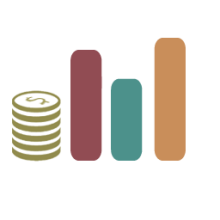Trends and challenges of investing for a sustainable and inclusive recovery
Work area(s)
The countries of Latin America and the Caribbean face a complex macroeconomic environment this year.
Domestically, weak economic growth is accompanied by strong inflationary pressures, slow job creation and falling investment in a context of growing social demands.
Externally, countries are facing increasing geopolitical tensions, flagging global economic growth and trade and higher prices for commodities, food and energy, which are feeding internal inflationary pressure. Higher interest rates in developed economies are contributing to slower global growth and have increased the cost of financing, which has adversely affected the countries of the region.
In this context, the slowdown in economic activity seen in the region in the first half of 2022 is expected to worsen in the second half of the year.
The region is returning to a path of slow growth
The region is returning to the path of slow growth that was characteristic before the pandemic. Before 2020, economic activity in the region had stalled; growth in the period between 2014 and 2019 was the lowest recorded since the 1950s.
Latin America: GDP growth rate, 1951–2020
(Percentages)

What are the macroeconomic policy challenges?
In the current context, the great challenge for macroeconomic policy is to manage the trade-offs between various macroeconomic objectives:
- Boosting sustainable growth
- Mitigating inflationary pressure
- Generating quality jobs
- Reducing poverty and inequality
- Boosting investment
Meeting the challenge will require better coordination between fiscal, monetary and exchange rate policies and taking advantage of the set of tools available to authorities.
Investment must be boosted to achieve sustainable and inclusive growth
Stalled at 19% of gross domestic product (GDP) over the past three decades, investment in the region is the lowest in the world and has become a structural hindrance to development in Latin America and the Caribbean. Reviving it is key to achieving sustainable, inclusive growth. In the current situation, particular attention must be paid to ensuring that growth and investment are not set aside in favour of the policies countries are enacting to stabilize inflation.
World and selected regions: investment as a share of GDP, 1990–2021
(Current dollars and percentages)

Challenges to boosting investment
- Reducing coordination problems that hinder the adoption of new and better technology to create virtuous cycles
- Fiscal incentives with the appropriate design and governance frameworks to mobilize private investment towards strategic sectors (crowding-in)
- National public investment systems are important in order to promote consistency, efficiency and effectiveness in public investment
- The green transition, together with increased demand for the minerals that are required by clean technologies (copper, iron and lithium), present an opportunity and also bring the challenges of adapting production methods and technologies
- Accessing long-term, concessional financing to respond to climate change and create low-carbon options for economic development
Macroeconomic policy efforts, both fiscal and monetary, must be complemented by industrial, innovation and technological development and by trade and social policies with a long-term outlook.Read the Economic Survey of Latin America and the Caribbean 2022
